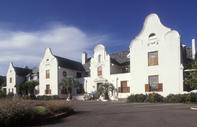Place of the Cheetahs
The city was originally known to the Sotho people as Mangaung, a name meaning 'place of the cheetahs'. Mangaung, is now the name of the Municipality, which governs Bloemfontein. Founded in 1846 by Major Henry Warden, the British Resident in Griqua territory, the settlement was named after the abundance of flowers that grew here in spring.

Since 1910, as the seat of the Court of Appeal, the city has been the judicial capital of South Africa. Bloemfontein occupies an important place in the country's more modern history: as it was here, in 1912, that the South African Native National Congress, renamed in 1923 as the African National Congress, was formed. One of the best ways to appreciate the city's many historic treasures is to follow the Rose Walk, which consists of two routes.
Amongst the places of interest are the Twee Toringkerk, 1880, the only twin-spired Dutch Reformed Church in the country, the Presidency, 1886, the official residence of the last three presidents of the Free State - and the First Raadsaal.
Built in 1849 as a school, this modest building, with its thatched roof and floor of smeared dung, became the first meeting chamber of the Free State Volksraad, or Parliament. The Fourth Raadsaal, completed in 1893, is a magnificent sandstone and red brick building with an entrance porch resembling a Greek temple.
Also of interest is the Edwardian-style Supreme Court, 1906, the National Women's Memorial, erected in memory of the Boer women and children who died in the South African War, and the adjoining War Museum. Highlights of the National Museum are a reconstruction of an early 1900s Bloemfontein street scene, with an extensive archaeological collection - including the 250 000-year-old Florisbad skull - and the country's largest collection of fossil ammonites.
Emily Hobhouse
If you feel strongly about it, do something about it, don't just complain. Follow the example of Emily Hobhouse, an Englishwoman who travelled halfway across the world to campaign on behalf of the women and children being held in concentration camps during the Anglo-Boer War, battling the authorities in South Africa and England to improve conditions.
She later wrote: 'It came quite naturally — in obedience to the feeling of unity or oneness of womanhood. It is when the community is shaken to its foundations, that a deeper unity of humanity evinces itself.' After the war she established schools to teach spinning and weaving, skills that would enable women to support themselves.
Hobhouse's ashes were interred at the National Women's Memorial in Bloemfontein. The Women's Memorial in Bloemfontein is dedicated to more than 25 000 women and children who died during the Anglo-Boer War. At the base of the 34-metre sandstone obelisk is a poignant sculpture of a woman wearing a traditional kappie gazing into the distance while another, seated, holds a dead child on her lap.
Oliewenhuis Art Museum

Naval Hill
'Dad, where do the ships park?' is a question that Free State fathers often have to explain. Those that did not sleep through history lessons will remember that Naval Hill's current name comes not from any mystifying nautical connection, but from the large naval guns that were placed up there by the British forces after they occupied Bloemfontein during the Second Anglo-Boer War.
The British had had to call on its navy to supply guns that could match the Boer Long Toms. Before that it had been known as Platberg. It was located on the original Bloemfontein farm, while today the hill stands central in the Franklin Game Reserve. An observatory was set up there in 1926 to house a 21-inch telescope to study double stars, but it has since been converted into a theatre. What many Bloem boys and girls remember best about the hill, however, is that it is where they had their first real kiss.
 Towns such as Ladybrand in the eastern Free State highlands have a reputation for fine old dressed-sandstone buildings....
Towns such as Ladybrand in the eastern Free State highlands have a reputation for fine old dressed-sandstone buildings....